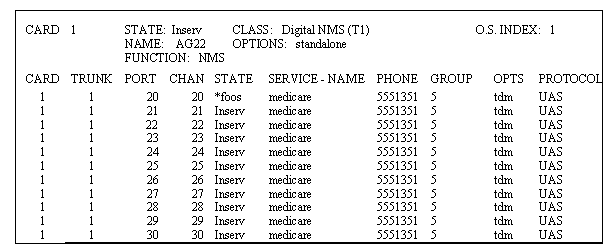

Regular monitoring of system operations helps you to spot problems before they become serious. This example takes you through system monitoring steps on a sample system, as completed by the system administrator for Integrity Insurance.
Making test calls
Every day, the system administrator makes phone calls to the same numbers used by customers, or has someone else in the group do that and report back. Calls are made during peak calling periods to ensure that the system is working well under heavy volume. The goal is to make sure that the following is occurring:
Today, when the system administrator makes the calls, a problem is apparent. When she calls the information line for supplementary Medicare coverage services, she keeps getting a busy signal. She has to call repeatedly to get through.
Viewing service operations live
When the Integrity system administrator has problems getting through to the Medicare number, she decides to check service operations right away by using the sysmon command.
To view service operations:
The system displays page 1 of the service activity matrix. The dynamic matrix shows activities on system channels as they occur, and changes frequently. The following static sample is for purposes of this example:

The matrix for Integrity's system shows all channels taking calls and performing call handling functions. However, channel 20 has a low number of calls when compared to the other channels. The Integrity system administrator decides to check the Message Log report to see if there are messages about hardware or communication failures.
Checking the Message Log report
Even if no problems are present, the Integrity system administrator checks the Message Log report daily. Checking the Message Log report daily is a good practice that you should follow as well.
To check the Message Log report:
The system displays the Message Log Report. A recent message shows that channel 20 has gone from the in service (INSERV) to the out of service (FOOS) state.
Thu Oct 3 11:37:20 2002 MTC
MTC002 NM CH 20 (MTC_STATE_EVENT)Changed state from INSERVE to FOOS.
Checking the Display Equipment screen
The next step is to check the Display Equipment screen for broken or out-of-service equipment. This is another screen that you should check every day.
To check the Display Equipment screen:
The system displays the Display Equipment screen. In the following sample, the administrator has scrolled down to see channel 20.

Channel 20 is in the facility out of service (foos) state. It is no longer taking calls, and the remaining channels are not adequate to handle service during busy periods. That is the cause of the problem. Diagnostic testing by Avaya or by the system administrator can further define the problem. For now, the system administrator may reassign channels from other services to make up for the loss of channel 20.